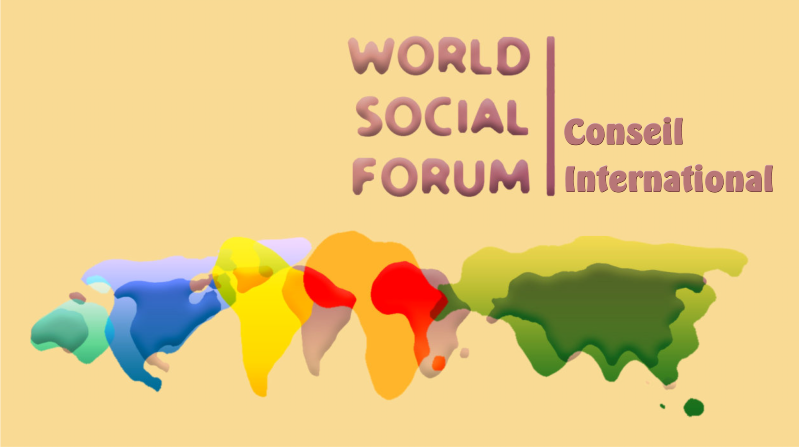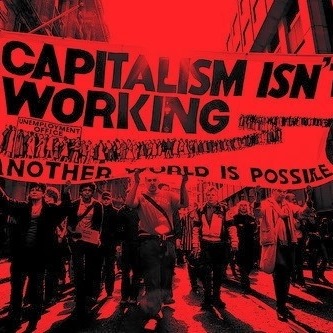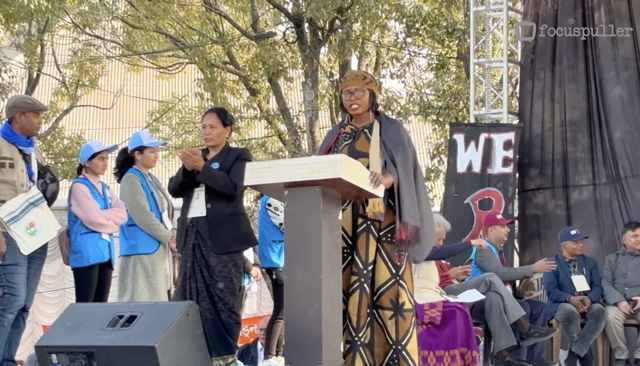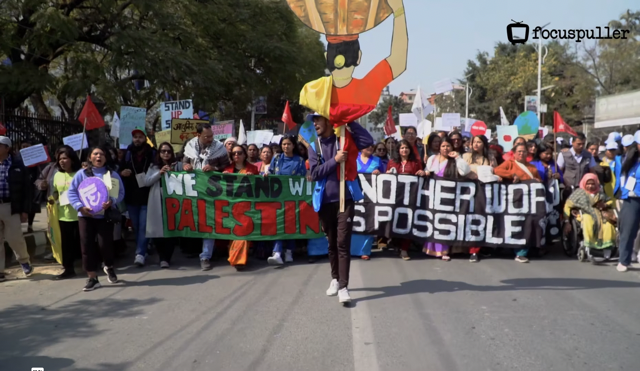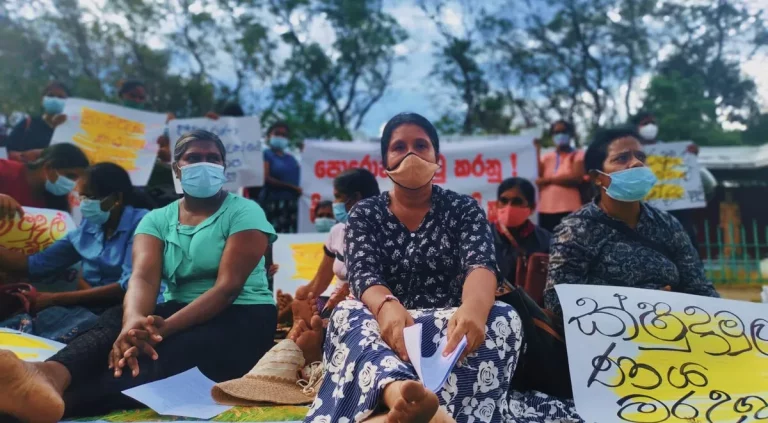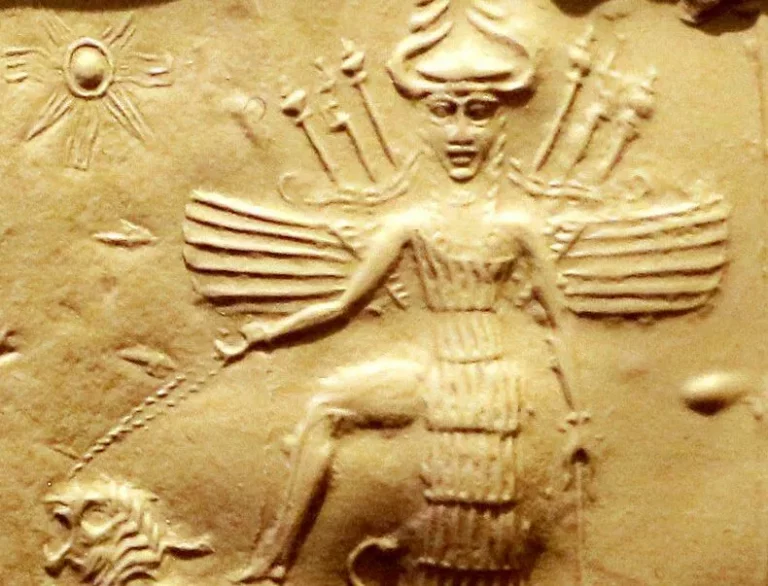In ‘Uhud Mountain’ [1] – a tall, abandoned building in Tahrir Square in central Baghdad, facing the Green Zone – young men and women protestors who had taken over the building chanted Inryd watan (We want a country) and Nazel akhuz haqqy (I am coming down to take my rights). Since the culmination of street protests in October 2019, Tahrir Square in central Baghdad, and several other main squares around the country, had been occupied by protestors. From October 25th 2019 and for a period of over year, they managed to retain control of these squares, where they established miniature ideal societies.
The 2019 uprising started as a protest movement that began mainly in the Shi‘a-dominated central and southern provinces and then spread across Iraq. Despite the bloody repression of the protests by Iraq’s security forces and the militias affiliated to the Iraqi political establishment, these demonstrations grew into an uprising as the youth and the disenfranchised that had launched the first street protests were joined by individuals from diverse social, educational and ideological backgrounds and groups, such as unions, syndicates and students’ organizations.
In many ways the October 2019 uprising was a continuation of several major popular protest movements (such as the ones in 2015 and in 2018) denouncing Iraq’s sectarian, corrupt and dysfunctional political system and the absence of basic services in the country. However, in its reach, form, and visibility, the 2019 uprising went beyond previous movements. One aspect of the uprising that was unprecedented was the extraordinary and massive participation of women – especially young women.
This article is based on in-depth fieldwork that was conducted with women and youth networks and social movements in Baghdad, Najaf-Kufa, Karbala and Nasriyah, as well as field observations in Basra. It takes the Iraqi uprising of 2019 as a framework for thinking about how massive protests allow for an understanding of emancipation that broadens our feminist imagination, paying particular attention to the space the uprising produced. [2] The perspective taken here breaks with binary approaches of agency and resistance in analysing the gendered and sexual dimensions of the uprising. Instead, the article examines the protests as both a massive corporeal presence in the streets, and an occupation of the cyberspace that allowed for the production of a discursive, material and imaginary space. Instead of defining a model of emancipation, the article sees as emancipatory any action or thought that challenges the ‘order of things’ and that asserts the equality and centrality of those who are usually not considered as ‘political’ agents.
A feminist analysis of the Iraqi uprising of 2019 attempts to bring together the structural and the political : on the one hand, it seeks to analyse what kind of space is being produced by the protestors ; and, on the other hand, it adopts an approach to emancipation that expands the meaning of what is ‘political’. Thus, instead of asking if women’s participation in the 2019 Iraqi uprising was ‘feminist’ or followed a ‘women’s rights’ agenda, it is more enlightening to ask if it challenged the dominant order of things, especially in the space it produced. Similarly, instead of starting with a preconceived idea of what constitutes a transgression of gender norms, an analysis of the different levels in which a mobilization is affecting social space provides an understanding of what is transgressive – and in what ways. [3]
POST-2003 IRAQ : NECROPOLITICS AND SEXTARIANISM
Iraq in the post-2003 period has witnessed a continuation and exacerbation of a process of militarization and state destruction that had started in the 1990s with the US-led coalition’s devastating bombings and the imposition of the United Nations sanctions, the harshest ever imposed on a country. [4] While the authoritarian regime of Saddam Hussein had already put the country through almost a decade of war with Iran in the 1980s, and violently repressed all forms of political opposition, the United Nations sanctions constituted an ‘invisible’ war that plunged the country into poverty and humanitarian crisis. The 2003 US-led invasion and occupation continued this process, establishing a political system based on ethno-sectarian and religious belongings (commonly called the muhasasa system) and destroying what remained of a functioning state. The US administration deprived the state’s institutions of their executives and employees through the so-called ‘de-baʿthification’ campaign, and it put into power a conservative and ethno-sectarian political elite. The post-2003 political establishment in Iraq functions as a heavily militarized kleptocratic and nepotist regime that monopolizes Iraq’s rich oil resources and represses civil society opposition.
Achille Mbembe’s concept of necropolitics [5] is useful in the Iraqi context, within the framework of racial capitalism and a postcolonial nation-state. It allows us to understand which lives are valuable and mourn-able, which deserve the infrastructural and political means of development, and which lives are not/do not. In today’s Iraq, necropolitics manifests itself in the absence of the vital infrastructure that is needed to enable everyday life to function, such as water, electricity, state services and institutions, including health and education services. It is also clear in the various forces of death that characterize Iraqi political life, from the state security apparatus to the Iranian-backed militias that repress any form of political opposition.
Since the start of the uprising in October 2019, at least 700 peaceful protestors have been killed and 25,000 injured, while many have disappeared. The repression has been conducted by various forces : state security forces use stun grenades, anti-riot tanks, military-grade tear gas, and bullets, while paramilitary groups, Iranian-backed militias and mercenaries use live ammunition and machine guns. The Iraqi government has also imposed media, internet and telecommunication blackouts, as well as curfews. Many protestors have been threatened, intimidated, arrested, beaten up, kidnapped and even assassinated.
In post-2003 Iraq, the urban public space has been deeply altered : it is militarized, privatized and fragmented. Baghdad has experienced sectarian violence and since 2006/07 has been divided by checkpoints and concrete T-walls separating neighbourhoods according to ethno-sectarian belonging. Class divisions are connected to political divisions as access to resources and wealth are closely related to membership of a network with strong ties to the political elite. The most striking separation in Baghdad is between the Green Zone, where the political elite reside, and the rest of the city’s inhabitants. Public lands have been privatized to allow for the construction of shopping malls through contracts that are provided within a system of bribery and corruption. These are all features of disaster capitalism, [6] where market fundamentalism pushes for aggressive privatization, often related to the grabbing of public lands and violent dispossession, while public services and infrastructure are dysfunctional or absent. The privatization of Iraq’s urban outdoor spaces, and of formally public services, such as electricity, education and health, along with militarization and ethno-sectarian fragmentation, have altered Iraqis’ everyday lives and their very ability to survive.
As is argued in feminist scholarship on war and armed conflict, militarization is deeply gendered and is crucial in defining gender norms and relations. [7] In Iraq, militarization as a social and political phenomenon was exacerbated during the war with Iran in the 1980s, and was pushed even further after the 1991 Gulf War and the imposition of the UN sanctions. Militarization plays a central role in shaping representations and practices of femininities and masculinities as it reinforces stereotypical roles of men as ‘protectors’ and women as ‘vulnerable’. The UN sanctions saw the emergence of new forms of patriarchy as extreme poverty pushed families and individuals to develop survival strategies. [8]
A deeply gendered ideology and politics characterize Iraq’s current political regime. In fact, the post-2003 Iraqi regime is not only based on ethnic, religious and sectarian division, it is also based on sexual division ; it is, to use Maya Mikdashi’s term, a sextarian regime. [9] A revealing example is that one of the first major legal reforms that was attempted (by one of the main Shi‘a Islamist political parties brought to power by the US administration through the invasion and occupation) was to abolish the Personal Status Code (PSC) – the legal framework that gathers together most women’s legal rights – and to replace it with a sectarian-based PSC.
The relationship between armed violence and the imposition of sextarianism is constitutive of Iraq’s regime, which extends from politicians elected to parliament to militia groups. Heteropatriarchal sectarian religious forces not only dominate the political sphere, but also the streets, through their armed groups and militias. This relationship was also very central in the repression of the October 2019 uprising, since any challenge to heteropatriarchal gender norms is perceived as a threat to the system as a whole. Through their media channels and social media platforms, the Iraqi political establishment often portrayed the uprising as ‘immoral’. Protestors were often accused of being sexually corrupt, and depraved, and all kinds of rumours were spread about supposedly ‘illicit behaviour’ among the youth in the tents set up in the country’s squares.
THE OCTOBER 2019 UPRISING : THE PRODUCTION OF SPACE
SAWT AL-MAR‘A THAWRA : A GENDERED EMANCIPATION
Most of the women who participated in the uprising explained that they took part in it in order to denounce the violence that the protestors, mostly young and male, had faced. As such, they did not differ from the mass of individuals from diverse social, educational and ideological backgrounds who took to the streets or cyberspace to protest the killing of unarmed peaceful protestors. The repression of the protests was deeply gendered as the mobilization of gender and sexual norms had been central to the attempt to disqualify the uprising on the basis of its being ‘immoral’ and a breach of societal and religious norms.
In many ways, the attacks on women protestors and the assertion of heteropatriarchal gender and sexual norms unleashed by Iraq’s political establishment can be understood as what Deniz Kandiyoti has called ‘masculinist restoration’ : [10] as women gain visibility and take up space, they are put back in their ‘place’ by these attacks. Women were also attacked on social media : the hashtag #بناتك_ياوطن – Banatek ya watan (Your young women, oh country), which was the slogan of the women’s protest of 13 February 2020, was turned into #عاهراتك_ياوطن – ‘Aheratek ya watan (Your whores, oh country). Women mobilized against these attacks : through messages displayed on the wall of the tunnel leading to Tahrir Square, and through placards held by young women during the protests, such as one reading ‘Women of the October revolution are revolutionaries not whores’. The slogan Sawt al-mar‘a thawra (A woman’s voice is a revolution) became central in the protests after these attacks were launched.
Along with slogans praising the Iraqi nation, the young women and men who participated in the protests openly addressed sexist discourse. For example, gender mixing (ikhtilat) during the protests was condemned by several Islamist political leaders, including the very controversial leader Moqtada al-Sadr. [11] By forbidding gender mixing and designating women’s voice as ‘awra (belonging to the private), Islamist political groups sought to define women’s participation in the protests as a breach of religious norms. Protestors mocked these declarations through many slogans, such as La mu ‘awra sawtech thawra (No it is not shameful, your voice is a revolution). Another challenge to male-dominated discursive space was the praise of one of the early martyrs of the protests, Safaa al-Sarai, referring to him as Ibn Thanwa (Son of Thanwa), in reference to his mother Thanwa – instead of referring to him by reference to his father’s name, as is usually done. Ibn Thanwa is now a name that is commonly used to refer to revolutionaries and many protestors use their mother’s name instead of their father’s names.
Despite these examples of gendered dissent, the October 2019 uprising did not include a feminist or women-centred agenda. How then do we make sense of women’s massive participation in the protests ? This apparent contradiction is not specific to the Iraqi context : it was also the case during the Arab uprising,– and perhaps all recent protest movements in the region. [12] The absence of a gender-specific agenda can be seen as revealing of the ways in which popular protests tend to homogenize slogans and demands, and thus end up being class- or gender-blind. However, looking at body politics and space can provide another reading of the absence of a clear feminist agenda. It can be argued that it was in its concrete enactment of equality, in the massive presence and mixing of bodies, that gender norms were challenged by the 2019 uprising. Women’s massive participation and presence constituted in and of itself a challenge to the sextarian social order.
Bodies are indeed central to the process of citizenship-making, in which gendered bodies become signifying agents of collective action and transformation, as was clear in the Banatek ya watan (Your young women, Oh country) women’s protest that was organized in February 2020 as part of the uprising. While this protest was a demonstration of young women’s support for the uprising, and of alignment with its main slogan, Inryd watan, women’s massive corporeal presence, along with male protestors (often acting as human shields around their march), challenged sextarianism. In this sense, women’s massive corporeal presence signified an anti-sextarian citizenship, as well as a rejection of necropolitics and a celebration of life in the post-2003 Iraqi context. Many of the protestors – both men and women – in Baghdad’s Tahrir Square expressed the fact that women’s presence meant ‘life’ : it signified the support of the entire society for the uprising. Departing from the notion of ‘resistance’, women’s corporeal presence produced an alternative material and discursive space. Furthermore, by not limiting themselves to mobilizing specifically as women, women deployed an emancipated self.
CONCLUSION : EXPANDING THE FEMINIST IMAGINATION
The 2019 Iraqi uprising produced an alternative discursive, material and imaginary space to the dominant post-2003 space characterized by militarization, privatization, and patriarchal domination. In this space lines and hierarchies between demands addressing government and electoral politics and slogans such as ‘the right to have curly hair’ are blurred. It was both in the collective corporeal occupation of outdoor spaces as much as in the presence in cyberspace that the lines and hierarchies between what are often deemed ‘political’ and ‘societal’ were challenged. It is in this sense that the practices and mobilizations of the uprising can be described as emancipated and political.
The madaniyya (civicness) put forward in the uprising involved ordinary people establishing a peaceful miniature society that was accepting of various aesthetics and forms, that provided essential services, and that was open to diverse opinions and beliefs. The space created by the uprising was thus a challenge to necropolitics. It offered the blossoming of different ways of living, and an enjoyment of social life disconnected from utilitarian consumption. It was in many ways similar to how Henri Lefebvre has described the Paris Commune : the 2019 Iraqi uprising was a big celebration, a space where life was enjoyed. [13]
The gender and sexual dimensions of the uprising were central, and the sextarian and heteropatriarchal repression of the political establishment was challenged in many ways : from anti-sexist slogans to women’s marches. Women’s massive corporeal presence in itself represented a questioning of sextarianism, which relies on sectarian and sexual divisions. Women did not differ from men, or from members of different social groups (based on class, education or profession), in justifying their participation in the uprising by reference to the goal of ‘honouring the martyrs’. All of this can be seen as revealing both the existence of gender and sexual divisions in Iraq, as well as emancipated forms of dissent that are not simply bound to women’s identity as women.
NOTES
[1] This tall and abandoned building had previously often been called the ‘Turkish restaurant’, but was renamed ‘Uhud Mountain’ by protestors in reference to the battle of Uhud in the time of the Prophet Muhammad.
[2] See for example the perspective developed by Lefebvre, H. (1968) Le Droit à la Ville. Paris : Point.
[3] See for example the perspective developed by Rancière J. (1987) Le Maître Ignorant : cinq leçons sur l’émancipation intellectuelle. Paris : Fayard.
[4] See Gordon, J. (2012) Invisible War. The United States and the Iraq sanctions. Harvard : Harvard University Press.
[5] See Mbembe, A. (2003) ‘Necropolitics’, Public Culture 15(1) : 11–40 (translated by Libby Meintjes)
[6] See Klein, N. (2007) The Shock Doctrine : The rise of disaster capitalism. New York : Metropolitan Books, Henry Holt.
[7] See for example Peterson V.S. (2007) ‘Thinking through intersectionality and War’, Race, Gender & Class 14 (3/4) : 10–27 ; Kandiyoti, D. (2007) ‘Between the hammer and the anvil : Post-conflict reconstruction, Islam and women’s rights’, Third World Quarterly 28(3) : 503–517 ; Cockburn, C. (2010) ‘Gender relations as causal in militarization and war’, International Feminist Journal of Politics 12(2) : 139–157.
[8] See Ali, Z. (2018) Women and Gender in Iraq : Between nation-building and fragmentation. Cambridge : Cambridge University Press.
[9] See Mikdashi, M. (2018) ‘Sextarianism : Notes on studying the Lebanese state’, in A. Ghazal and J. Hanssen. (eds.) The Oxford Handbook of Contemporary Middle Eastern and North African History. Oxford : Oxford Handbooks Online. doi:10.1093/oxfordhb/9780199672530.013.42.
[10] Kandiyoti, D. (2014) ‘Contesting patriarchy-as-governance : Lessons from youth-led activism, OpenDemocracy, 7 March 2014.
[11] Leader of the Sadrist Islamist movement formed after the invasion and occupation of 2003, which is one of the major Shi‘a Islamist forces in Iraq.
[12] See Hasso, F. and Salime, Z. (eds.) (2016) Freedom Without Permission : Bodies and space in the Arab revolutions. Durham and London : Duke University Press.
[13] See Lefebvre, H. (1965) La Proclamation de la Commune. 26 mars 1871. Paris : Gallimard.
